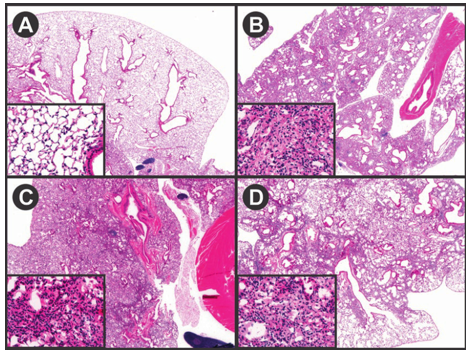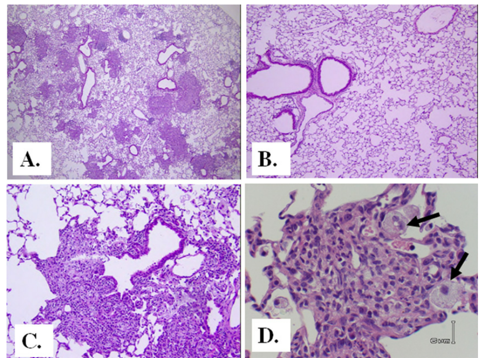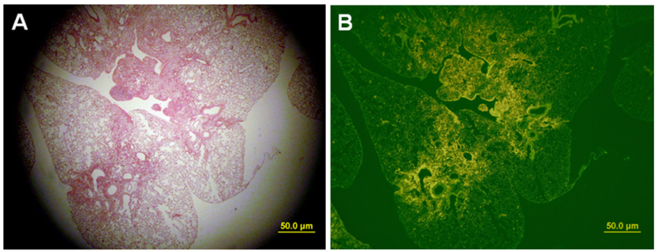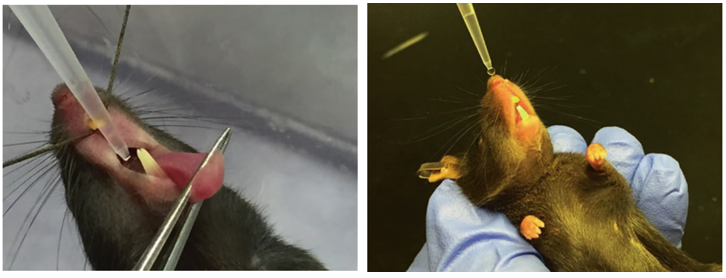Pulmonary Fibrosis Models
Pulmonary fibrosis consists of heterogeneous pulmonary disorders characterized by progressive dyspnea, cough, restrictive physiology, impaired gas exchange, and respiratory failure. Irrespective of the etiology, the pathogenesis of all forms of pulmonary fibrosis is incompletely understood. The histologic hallmark of pulmonary fibrosis is a pattern of usual interstitial pneumonia (UIP) on lung tissue from surgical biopsies or at autopsy. Traditional models of fibrosis have led to important insights into disease pathobiology, including features of inflammation, fibroproliferation, and many gene expression changes seen in murine models.
Creative Bioarray provides various in vivo pulmonary fibrosis assays, including disease models induced by bleomycin, silica, and fluorescein Isothiocyanate(FITC).
Pulmonary Fibrosis Models
- Bleomycin
Bleomycin is a family of complex glycopeptides with anti-neoplastic properties. Bleomycin-induced toxicity occurs predominantly in the organs of the lung, skin, and mucous membranes due to the lack of the bleomycin-inactivating enzyme in those tissues. Pulmonary fibrosis is a side effect of bleomycin. Because the lung expresses deficient levels of this enzyme, this enables persistence of the compound with consequent greater susceptibility to bleomycin-induced lung injury relative to other organs. This notable and undesirable side effect of bleomycin leads to its use in animal models studying mechanisms of pulmonary fibrosis.
 Figure 1. Mice's lung histopathology after a single dose of bleomycin treatment. Representative hematoxylin- and eosin-stained lung tissue sections are shown. The mice were sacrificed at 3 (a and b), 6 (c), and 12 (d) weeks after bleomycin instillation. Except for the PBS control (a), all panels showed lung sections from bleomycin-treated mice(Rittié, 2017).
Figure 1. Mice's lung histopathology after a single dose of bleomycin treatment. Representative hematoxylin- and eosin-stained lung tissue sections are shown. The mice were sacrificed at 3 (a and b), 6 (c), and 12 (d) weeks after bleomycin instillation. Except for the PBS control (a), all panels showed lung sections from bleomycin-treated mice(Rittié, 2017).
- Silica
Dropping silicon dioxide into the lungs of mice will cause the formation of fibrotic nodules, similar to superficial silicified nodular fibrosis, which occurs in humans after some occupational exposures. Silica remains in the lungs, and this response is characterized by persistent, toxic, and inflammatory responses. Fibrotic nodules are formed around the silica deposits, and the silica particles are easily identified by histology and polarized light microscopy.
 Figure 2. Intratracheal silica injury leads to multinodular fibrosis (A), predominantly in the alveolar parenchyma and terminal bronchioles (C). Activated macrophages are predominant in these lesions (D, arrows). (B) Control lung section(B. Moore et al., 2013).
Figure 2. Intratracheal silica injury leads to multinodular fibrosis (A), predominantly in the alveolar parenchyma and terminal bronchioles (C). Activated macrophages are predominant in these lesions (D, arrows). (B) Control lung section(B. Moore et al., 2013).
- FITC
Fluorescein isothiocyanate (FITC) is also used as a lung injury model that causes fibrosis. Intratracheal delivery of FITC to the lungs leads to increased alveolar and vascular permeability, leading to pulmonary fibrosis within 14 to 21 days. In the most beneficial aspect of this model, FITC binds to the parenchymal protein and remains continuously localized in the initial injury area. This allows researchers to use immunofluorescence to locate the injured lung area.
 Figure 3. Fibrosis develops in areas of fluorescein isothiocyanate (FITC)deposition. Hematoxylin-and-eosin staining shows patchy areas of fibrosis and consolidation (A), which line up well with areas of FITC deposition(B)(B. Moore et al., 2013).
Figure 3. Fibrosis develops in areas of fluorescein isothiocyanate (FITC)deposition. Hematoxylin-and-eosin staining shows patchy areas of fibrosis and consolidation (A), which line up well with areas of FITC deposition(B)(B. Moore et al., 2013).
Administration Method
The various induction methods mentioned above can be through oral, nasal, or atomization.
 Figure 4. Administration methods. (A)Trans-oral administration of bleomycin using a pipette tip applied to the posterior oropharynx and sterile forceps to manipulate the tongue carefully; (B)Intranasal injection in mice (obligate nose breathers) postanesthesia(O'Dwyer & Moore, 2018).
Figure 4. Administration methods. (A)Trans-oral administration of bleomycin using a pipette tip applied to the posterior oropharynx and sterile forceps to manipulate the tongue carefully; (B)Intranasal injection in mice (obligate nose breathers) postanesthesia(O'Dwyer & Moore, 2018).
Assays available
- Hydroxyproline Assay
- Histologic Assessment
- Gene expression analysis
- Protein expression testing
Applications
- To evaluate the preventive and therapeutic effects of drugs on the occurrence and development of diseases.
- To explore the mechanism of drug action.
Quotation and ordering
If you have any special needs or questions regarding our services, please feel free to contact us. We look forward to cooperating with you in the future.
References
- B. Moore, B.; et al. Animal Models of Fibrotic Lung Disease. American Journal of Respiratory Cell and Molecular Biology, (2013), 49(2), 167-179.
- O'Dwyer, D. N.; Moore, B. B. Animal Models of Pulmonary Fibrosis. In S. Alper & W. J. Janssen (Eds.), Lung Innate Immunity and Inflammation (Vol. 1809, pp. 363-378). Springer New York. (2018).
- Rittié, L. (Ed.).. Fibrosis: Methods and Protocols (Vol. 1627). Springer New York. (2017).